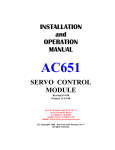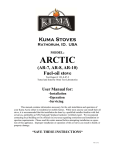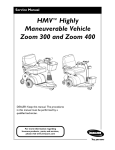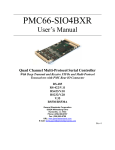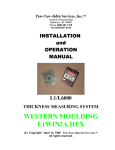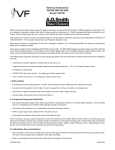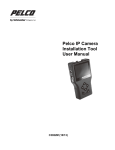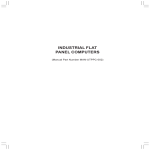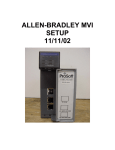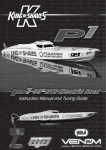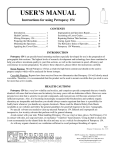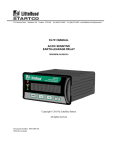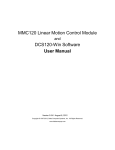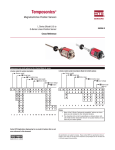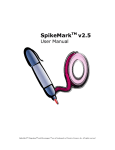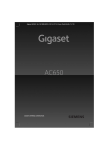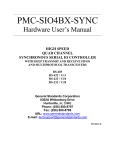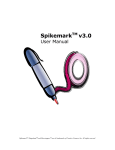Download AC650 Manual PDF - Paw-Taw
Transcript
AC650 SERVO CONTROLLED SETWORKS SYSTEMS TUTORIAL & TECHNICAL REFERENCE Paw-Taw-John Services, Inc. Phone (208) 687-1478 N. 18125 Ramsey Road Rathdrum, ID 83858 e-mail [email protected] FAX (208) 687-4148 AC650 SERVO CONTROLLED SETWORKS SYSTEMS Table of Contents CHAPTER 1 - INTRODUCTION ABOUT THIS TUTORIAL & TECHNICAL REFERENCE ABOUT Paw-Taw-John Services, Inc. ABOUT SERVO CONTROLLERS Paw-Taw-John Services, Inc. SERVO CONTROL SYSTEMS TYPICAL SYSTEM COMPONENTS CONFIGURATION OPTIONS 1 1 2 2 4 5 CHAPTER 2 - SYSTEM INSTALLATION SERVO SYSTEM COMPONENTS GENERAL INSTALLATION NOTES MECHANICAL INSTALLATION ELECTRICAL SPECIFICATIONS ELECTRICAL INSTALLATION ELECTRICAL INSTALLATION CHECKLIST 7 8 8 9 11 13 CHAPTER 3 - INITIAL SERVO SYSTEM SETUP HARDWARE CHECKOUT INITIAL SERVO SYSTEM SETUP VOLTAGE TESTS AND WIRING CHECKS AC650 CARD ADDRESS SETUP AC650 CARD SERVO OUTPUT SETUP TransTerm 5 (TT5 KEYPAD) SETUP 15 17 17 18 19 20 CHAPTER 4 – SERVO LOOP DYNAMICS SETUP SERVO LOOP DYNAMICS SETUP OFFSET CALIBRATION PROCEDURE AC650 FACE PLATE INDICATIONS AC650 SERVO LOOP SETUP USING 486DX MONITOR SCREEN 23 25 26 28 CHAPTER 5 - SYSTEM OPERATION TransTerm 5 TERMINAL OPERATION DEFINITION OF SYSTEM PARAMETERS SETTING THE SAW OFFSET REFERENCES TO ZERO SYSTEM RESPONSE SETTING TEMP SCALE ALTERNATIVE TEMPO SCALE FORMULA SETTING SYSTEM PARAMETERS ENTERING SPECIES SET SIZES OFFSET CALIBRATION PROCEDURE AUTO NULL FUNCTION SERVO VALVE GENERAL INFORMATION Paw-Taw-John Services, Inc. AC650 Table of Contents 31 32 33 34 36 38 39 41 41 43 44 07/22/03 CHAPTER 6 - RUNNING THE SETWORKS SYSTEM SYSTEM TURN ON OPERATING THE SETWORKS SYSTEM POWER DOWN AC650 PARAMETERS DOCUMENTATION SHEET AC650 NEW PARAMETERS 49 49 49 50 51 CHAPTER 7 -TROUBLESHOOTING INITIAL SYSTEM TROUBLESHOOTING OPERATIONAL SYSTEM TROUBLESHOOTING TransTerm 5 (TT5 Keypad) TROUBLESHOOTING HYDRAULIC CONTROL SYSTEM TROUBLESHOOTING HYDRAULIC CONTROL VALVE TROUBLESHOOTING FOR CONVENTIONAL CARRIAGES 53 54 55 56 57 CHAPTER 8 - MTS TEMPOSONICS PROBE REPLACEMENT REMOVAL OF PROBES INSTALLATION OF PROBES 58 59 CHAPTER 9 - IC REMOVAL PROGRAM IC REMOVAL AND INSTALLATION 61 CHAPTER 10 - PRODUCT INFORMATION PRODUCT WARRANTY SALE AGREEMENT TERMS AND CONDITIONS SERVICE AGREEMENT 63 65 67 CHAPTER 11 - DRAWINGS ELECTRICAL DRAWINGS MECHANICAL DRAWINGS INSTALLATION DRAWINGS 69 69 70 NOTES BLANK PAGE FOR NOTES 71 GENERAL SCHEMATICS & DRAWINGS AC650 LAYOUT VOLT TEST DWG-1 TO DWG 10 Paw-Taw-John Services, Inc. AC650 Table of Contents 07/22/03 CHAPTER 1 - INTRODUCTION ABOUT THIS TUTORIAL & TECHNICAL REFERENCE Paw-Taw-John Services, Inc.™ provides this Technical Reference Tutorial as an instructional aid for system design, installation, and operation of AC650 Servo Controller Card based setworks systems. Single or multiple axis systems, for saw and/or linebar positioning, carriage systems or any other linear position control, may be implemented using one or more AC650 Servo Controller Cards in conjunction with Temposonic® probes, servo or proportional valves and some type of operator control. While most systems are semi-custom in design and function, the operation of the AC650 Servo Controller Card remains constant. Therefore, understanding the AC650 becomes very important for system designers, installers, maintainers, and operators. The information included in this Technical Reference Tutorial is generic to most PawTaw-John Services, Inc.™ setworks systems and should be followed for installation, setup, and operation. Information that is specific to a particular system, such as mechanical and electrical drawings and schematics, control location and operation, and parts lists, is provided in addition to this manual. ABOUT Paw-Taw-John Services, Inc.™ Paw-Taw-John Services, Inc.™ is a designer and manufacturer of semi-custom servo controller systems and associated components used in wood products and other manufacturing industries. The company brings together individuals with decades of experience in systems and software design, custom electrical and electronic systems manufacturing, and technical sales with expertise in sawmill operation and automation. Paw-Taw-John Services, Inc.™ specializes in systems that provide greater user flexibility, lower maintenance, increased productivity, quicker pay-back, and higher yield. Our systems are in use worldwide by companies wanting more intelligence with their controllers. Paw-Taw-John Services, Inc.™ systems are easier to setup, modify, and use in everyday operation than most other programmable controllers. No special programming language must be learned and all programming may be done from a keypad terminal provided with the system. Our systems also interface with most popular position and limit sensors directly or via economical interface boxes we can supply with systems. Paw-Taw-John Services, Inc.™ can also control most all popular servo and proportional valves directly. This offers a significant reduction in equipment suppliers required to construct your servo system. Paw-Taw-John Services, Inc. Chapter 1 – Introduction 1/30/00 -1- ABOUT SERVO CONTROLLERS A servo control system, when applied to positioning, is an electro-mechanical system that knows where it is at all times and provides for external data input, whether from sensors, computers, or humans, to act upon or produce a response to the input. Most often in industrial applications the servo system is used to control linear motion such as positioning of a saw or movement of knees on carriages. Each isolated linear motion is referred to as an axis. Paw-Taw-John Services, Inc.™ systems are used to control one or more axes. Several of the axes may be interactive in multi-axis systems such as moving multiple saws simultaneously while still permitting individual saw adjustment. A typical servo control system might consist of a hydraulic cylinder used to move a saw. A servo valve under the control of the servo controller directs the hydraulic fluid power. Some type of position sensor attached to the saw would provide positional data to the controller. To make the system usable, an operator console might permit the selection of several cut lengths. In a real-time example the operator could choose a 10” cut width by pressing the 10” button on the console. This requests the servo controller to move the saw to the 10” position. The controller sends a signal to the servo valve to move the hydraulic cylinder in the correct direction. Information returned to the controller from the saw position sensor is compared with the operator-requested position and movement of the cylinder continues until the saw position reaches 10”. At that position the controller removes the signal from the servo valve and the saw stops. Paw-Taw-John Services, Inc.™ SERVO CONTROL SYSTEMS Paw-Taw-John Services, Inc.™ servo controllers are semi-custom systems designed and assembled from a group of standard components. The heart of the system is an AC650 servo control module. The AC650 is designed to accept positional information from many industry standard sensors. It will output the appropriate control for most industry standard servo valves. Eight inputs are provided for sensing operator switches, limit switches, or photo eyes and eight outputs can be used to drive lamps, relays, or alarms. Paw-Taw-John Services, Inc. Chapter 1 – Introduction 1/30/00 -2- The specific operating characteristics and personality of the AC650 are a function of the firmware programming that directs the microcontroller contained within. This program is created special to meet each system’s specific operating requirements. The AC650 servo controller high speed serial communications port may be connected to a terminal or computer via a telephone style modular jack for system setups and calibration, data tracking, and certain operating program modifications. Presently the Computerwise TransTerm 5 terminal is used. This feature allows the user on-site setup changes or accommodates for mechanical component wear or replacements. One final serial communications port allows several AC650s to intercommunicate making possible multiple controller systems that can work in harmony. In this manner one command from a control console might permit separate and different actions from two or more controllers simultaneously. The AC650 has 8 inputs and 8 outputs that can operate between 5vdc to 30vdc. A 4position dip switch, located on the component side of the circuit board, provides the addressing necessary in multiple card configurations and for special functions. The AC650 operates from a Firmware program stored in a 28-pin memory IC. The card has another memory device for storing set and servo dynamics parameters, stroke limits, and transducer interfacing information. Both of these devices are non-volatile so their data is not lost if power is removed. The main I/O connector opposite of the face of the card is an Euro-style 32 pin dual readout. This provides the card with flexibility to mount in single or multiple cardrack configurations. A complete custom Paw-Taw-John Services, Inc.™ servo control system is built from one or more AC650 controllers. Servo systems also typically include power supplies, wire and cable terminating blocks, suitable enclosures and custom operator panels. Paw-Taw-John Services, Inc. Chapter 1 – Introduction 1/30/00 -3- TYPICAL SYSTEM COMPONENTS A typical servo system from Paw-Taw-John Services, Inc.™ will be constructed from one or more of the components below: 1. System Control Enclosure: The servo control enclosure contains a cardrack used for support and interconnection to one or more AC650 Servo Controller Cards, power supplies necessary to operate the controller cards and other system components, AC power switch and fuses and suitable terminal blocks for connecting external component wiring. All of these parts are housed in a NEMA 12 enclosure designed for wall mount. Care is taken in design to provide wire ducting so that primary AC and secondary DC may be kept separated. The enclosure should be drilled for attachment of conduits during installation. 2. Temposonic® Probe: A linear transducer mounted inside the center of each cylinder used to measure position. A magnet that moves with the piston reflects an internal square wave generated at the probe head. The reflected wave is processed and provides accuracy to 0.001 inches. 3. Recirculation Box: The recirculation box contains a circuit card (AC700) that distributes the servo drive and Temposonics’ signals for a single axis. A system may have one or more recirculation boxes. The card controls the number of “recirculations” that the position signal will make in the Temposonics® probe. The more recirculations the greater the resolution. The AC700 also sets the probe operating frequency and triggering signal. Please refer to recirculation box manuals for setup and operation information. 4. Operator Control Panel: The Operator Control Panel is the main user system operating and control interface. This panel is typically custom designed and constructed to suit the requirements of the servo system. An assortment of Set control lighted push-button switches and other switches or joysticks for jog and cut control allow the operator to control the system. This panel is connected to the System Control Enclosure via a multi-conductor cable. 5. TransTerm 5 Terminal: The keypad terminal is used to display system status and adjust operating parameters, axis offsets, jog functions and troubleshooting. Refer to the System Operation section of this manual for specific operating details. The TransTerm 5 terminal connects directly to the AC650 cards inside the System Control Enclosure. 6. Servo/Proportional Valves: Servo Valves-and in some systems proportional valves-control the flow of hydraulic pressure to the hydraulic cylinders. One valve will be associated with each Paw-Taw-John Services, Inc. Chapter 1 – Introduction 1/30/00 -4- axis. The Servo Valves are controlled from the servo output of AC650 cards located in the System Control Enclosure. Refer to the system installation section of this manual for adjustments to the AC650 that may be required by any specific valve type. 7. Personal Computer based System: PC’s are used with high performance machine applications. These systems use all of the above items (with the exception of the TransTerm 5), but are controlled through the use of a high speed serial interface. These systems are used on optimizers, carriages, multiple axis quads and other specialized machines. When a personal computer is used, the TransTerm 5 is not. CONFIGURATION OPTIONS 1. 486DX computer to AC650MB card rack. 486DX computer AC650MB cardrack Communications cable 2. 486DX computer to multiple card rack system Paw-Taw-John Services, Inc. Chapter 1 – Introduction 1/30/00 -5- 3. Transterm 5 handheld terminal to single card rack Paw-Taw-John Services, Inc. Chapter 1 – Introduction 1/30/00 -6- CHAPTER 2 – SYSTEM INSTALLATION SERVO SYSTEM COMPONENTS Servo control systems are made up of numerous components generally procured from several vendors. The specific servo system components are generally somewhat standard but the source for each component can vary as established by the system designer. The following items will be delivered in one or more boxes for servo control systems designed using controllers from Paw-Taw-John Services, Inc.™ Please conduct an inventory upon receipt of the shipment to confirm all items are accounted for and are not damaged. System Control Enclosure (manufactured by Paw-Taw-John Services, Inc.™ to system designer’s specifications) TransTerm 5 keypad terminal (manufactured by Computerwise, Inc. and provided with the system from Paw-Taw-John Services, Inc.™) Servo Operator Control Panel (supplied by user or custom manufactured by Paw-Taw-John Services, Inc™. to user requirements) AC700 / Recirculation Box(s) (may be required depending on type of Temposonics probes used in the system. These may be manufactured by Paw-Taw-John Services, Inc.™) Paw-Taw-John Services, Inc.™ Installation and Operation Manual, a system specific document, (generally shipped inside the system control enclosure) Numerous other components will be used to make up the system but the items directly associated with the servo control function will include: Control Valve(s) (servo or proportional valves, one per axis to be controlled, part of hydraulic system) Temposonics Probe(s) (one per axis to be controlled as specified by system designer, manufactured by MTS Sensors and may be provided by Paw-Taw-John Services, Inc.™) Conduit and wire as specified by the system designer. Hydraulic cylinders, pumps, piping and hoses specified by the system designer. GENERAL INSTALLATION NOTES Paw-Taw-John Services, Inc.™ setworks systems employ several standard components but are semi-custom designs to best fit the user's application. Therefore, some components and installation requirements may differ from system to system. This installation chapter is designed as a guide to get the system installed and running quickly, safely and accurately. Installation should be conducted and supervised by knowledgeable and experienced electricians. Some judgment and interpretation may be required beyond the individual step-by-step procedures presented in this manual. Paw-Taw-John Services, Inc.™ supplies all components specified in the system quotation. Most installations will require additional materials such as conduit, wire, circuit breakers, etc. These items must be provided by the user or installer to complete the installation task. Paw-Taw-John Services, Inc.™ also provides drawings and wire lists etc. that are specific to the system being installed. Where possible, installation drawings will be shipped before the system to permit rough-in or location planning. Additional and useful sample drawings are located at the end of this manual. If questions or problems arise with the installation please call Paw-Taw-John Services, Inc.™ at (208) 687-1478. Assistance is available over the phone. Paw-TawJohn Services, Inc.™ also provides system design services under contract. MECHANICAL INSTALLATION Mechanical installation of the servo control system must conform to NEC standards applicable at time of installation because these enclosures contain electrical circuits. Therefore, component and enclosure location and mounting must be in accordance with the voltages contained within each system component and other components in the immediate area. It is advisable to mount enclosures on surfaces where vibration will be minimized. Proceed with mechanical installation using the following steps as a guide. 1. 2. 3. Mount the System Control Panel in a cool, dirt free environment. However, this enclosure has a NEMA 12 rating and may be mounted in more harsh environments if necessary. Mount the Operator Panel in an ergonomic way so the operator has unobstructed access to all controls for ease of operation. When AC700 Temposonics Recirculation Boxes are used to interface to Temposonics probes, they should be mounted to protect the connectors and box from mechanical damage. Cabling should also be routed and protected from damage. 4. 5. 6. 7. 8. 9. Sometimes J-boxes are used to terminate the Temposonics probe and servo valve cables. These boxes should be mounted so there is no interference with the machinery. Temposonics probes mounted in hydraulic cylinders should be easily accessible and allow sufficient clearance to pull the entire probe out of the cylinder. The blue cap end of Temposonics probes also should be protected from physical damage. If not, the probe end can be stepped on or hit with a foreign object causing irreparable damage. The Temposonics probe should be mounted in an area free from moisture or wet sawdust. If this is not possible-to keep the area clean-some type of additional protection must be fabricated. Some systems may require additional J-boxes for either AC or DC cabling and connections. In this case refer to the System Conduit and Cabling Design Guide drawing (in the drawing section of this manual) for guidance in location and mounting. Some systems (carriages) may also require pantographs for cable interface. Refer to mechanical drawing section of this manual for design guide drawings. ELECTRICAL SPECIFICATIONS Electrical Specifications are as follows: 1. System power requirements are 115 VAC, 60 HZ, breakered at 20 Amps. 2. System DC power used are: +5VDC +15VDC -15VDC +24VDC Amp requirements are figured per the number of discrete items used. Power supplies are selected for twice the amount of current used. + and - 12VDC are occasionally used. 3. TransTerm 5 handheld computer terminal power requirements are as follows: +12VDC or Vrms, 2-wire Frequency: 47-63 Hertz Current(Max): 500 milliamps A 12 VDC power charger can be used if no power is used from the computer system. 4. AC650 power requirements are as follows: +5VDC @ 400mA +15VDC @ 200mA (With TransTerm 5 connected, +15VDC @ 700mA) -15VDC @ 100mA +24VDC @ 400mA 5. AC700 power requirements are as follows: +5VDC @ 100mA +15VDC @ 100mA -15VDC @ 100mA If a +5VDC regulator is used on this board, the +15VDC amp requirement goes to 500mA. 6. MTS I Temposonics power requirements are as follows: +15VDC @ 100mA - 15VDC @ 75mA +12VDC @ 50mA 7. MTS II Temposonics power requirements are as follows: +/- 12VDC to +/-15VDC @ 140mA 8. MTS LP Temposonics power requirements are as follows: +15VDC to +24VDC, +/- 10% @ 100mA 9. MTS LH Temposonics power requirements are as follows: +13.5 to 26.4 VDC @ 100mA ELECTRICAL INSTALLATION The electrical installation of the servo system is also governed by NEC regulations. Specific attention must be paid to conduit fill rations based on the type of wire used. Care should also be given to system and enclosure grounding. Some additional electrical installation suggestions are: 1. 2. 3. 4. 6. 7. All AC wire to power terminals in the System Control Enclosure should be 16 gauge minimum. Input AC is 120 VAC and should be protected with a 15A breaker at the electrical distribution panel. All AC wire runs and DC wire runs should be put in separate rigid conduits. Color codes for AC are: a) AC Hot Black THHN or equivalent b) AC Neutral White THHN or equivalent c) Ground Green THHN or equivalent Power supplies used in Paw-Taw-John Services, Inc.™ systems are isolated linear supplies and therefore, no Isolation Transformers are required. All DC power wires used in the Paw-Taw-John Services, Inc.™ System Control Enclosures are wired to the following color code: a) +24 VDC Orange MTW 16 or 18 gauge b) +15 VDC Yellow MTW 16 or 18 gauge c) -15 VDC Blue MTW 16 or 18 gauge d) +5 VDC Red MTW 16 or 18 gauge e) DC Ground Black MTW 16 or 18 gauge f) Earth Ground Green MTW 16 or 18 gauge g) +12 VDC Brown MTW 16 or 18 gauge h) -12 VDC Violet MTW 16 or 18 gauge Proceed with electrical installation as follows: 1. Route a 9-pair cable (Manhattan E-95534) between the Operator Panel and the System Control Enclosure. 2. Connect a wire to each Input and Output of the AC650 cardrack following the wire colors of the stubs left on the terminals from the factory. 3. Wire the other end of the cable to the Operator Panel also following the wire colors of the stubs left on the terminals from the factory. 4. Route each of the 6 6-Pair cables (Manhattan M-39150) from the System Control Cabinet to each AC700 Recirculation Box. (NOTE: Number each cable at each end for identification.) 5. In the System Control Cabinet connect each cable to the AC650 cardrack. Connect Tempo/Servo outputs and power supply terminals as shown on the System Schematic. 6. Connect the other end of each cable to the terminals of the AC700 as shown on the Temposonics/Recirc. Wiring drawing. 7. Connect the Temposonics Probe and servo valve connectors to the AC700. 8. Connect Proportional Valve cables supplied by Paw-Taw-John Services, Inc.™ between each AC700 and respective valve. 9. 10. Route AC input power from the electrical supply panel (15A circuit breaker) and the System Control Cabinet. Connect this circuit to terminals provided in the upper left of the cabinet as shown on the system Schematic. ELECTRICAL INSTALLATION CHECKLIST Please refer to the system Interconnect Wiring Drawing at the back of this manual for the following steps. Paw-Taw-John Services has left cable stubs connected at all termination points as “an assistance” for cable and color coding reference. Should a wire come loose, refer to the drawing for the correct connection. Check off each step as completed. Pull a Manhattan P/N 13330 cable into conduit between Operator Control Panel and System Control Cabinet. Cut, strip and connect wires in the Operator Control Panel in the same sequence as (and in place of) the wire stubs on the terminal blocks. Tighten screws securely. Cut, strip and connect wires in the System Control Cabinet in the same sequence as (and in place of) the wire stubs on the terminal blocks at the bottom edge of the AC650 enclosure. Tighten screws securely. Pull a Manhattan P/N 39150 (or equivalent) cable between the Machine end Linebar AC700 enclosure and the System control Cabinet for Axis 1. Cut, strip and connect wires in the AC700 enclosure in the same sequence as (and in place of) the wire stubs on the terminal blocks. Tighten screws securely. Pairs 5 & 6 must be wire nutted to Black and Orange wires inside enclosure. In the System Control Cabinet, cut, strip and connect the wires of pairs 1 and 2 in the same sequence as (and in place of) the wire stubs on the terminal blocks at AXIS 1 on the top edge of the AC650 enclosure. Connect Pairs 3 through 6 to the power terminal blocks at the right side of the cabinet. Tighten all screws securely. Pull a Manhattan P/N 39150 (or equivalent) cable between the Operator end Linebar AC700 enclosure and the System control Cabinet for Axis 2. Cut, strip and connect wires in the AC700 enclosure in the same sequence as (and in place of) the wire stubs on the terminal blocks. Tighten screws securely. Pairs 5 & 6 must be wire nutted to Black and Orange wires inside enclosure. In the System Control Cabinet, cut, strip and connect the wires of pairs 1 and 2 in the same sequence as (and in place of) the wire stubs on the terminal blocks at AXIS 2 on the top edge of the AC650 enclosure. Connect Pairs 3 through 6 to the power terminal blocks at the right side of the cabinet. Tighten all screws securely. Pull a Manhattan P/N 39150 (or equivalent) cable between the Saw AC700 enclosure and the System control Cabinet for Axis 3. Cut, strip and connect wires in the AC700 enclosure in the same sequence as (and in place of) the wire stubs on the terminal blocks. Tighten screws securely. Pairs 5 & 6 must be wire nutted to Black and Orange wires inside enclosure. In the System Control Cabinet, cut, strip and connect the wires of pairs 1 and 2 in the same sequence as (and in place of) the wire stubs on the terminal blocks at AXIS 3 on the top edge of the AC650 enclosure. Connect Pairs 3 through 6 to the power terminal blocks at the right side of the cabinet. Tighten all screws securely. At each AC700 location (3), connect the Temposonics probe plug into the lower jack at the right side of the enclosure. At each AC700 location (3), install a jumper cable (supplied) between the AC700 upper jack at the right side of the enclosure and the Servo Valve. This completes all low voltage DC wiring. Clean wiring scraps from each enclosure and dress wires/cables for appearance and safety. Installation of the primary 120VAC must follow all safety regulations and precautions. Pull a #14 GA Black, White, and Green wire from the electrical service panel to the System Control Cabinet. In the System cabinet, strip and connect the Black wire to the AC IN terminal. Strip and connect the White wire to the N terminal. Strip and connect the Green wire to the GND terminal. In the electrical service panel, strip and connect the Black wire to a 15Amp circuit breaker. Strip and connect the White wire to a Neutral terminal. Strip and connect the Green wire to an electrical equipment ground terminal. All Setworks wiring is now complete. CHAPTER 3 - AC650 INITIAL SERVO SYSTEM SETUP HARDWARE CHECKOUT WARNING INSURE ALL LOCAL LOCKOUT PROCEDURES ARE FOLLOWED!!! AC650 CARD RACK CONFIGURATION M A S T E R S L A V E Refer to figure above for the following check. 1. Ensure 4 Master jumpers wires are installed near card 1 connector. 2. Install if not present. NOTE: In multiple card rack configurations, the second rack has 4 jumpers installed in the Slave locations. MULTIPLE AC650 CARD RACK CONFIGURATION Refer to drawing below. 1. Install jumper cable between GSC 2 of rack 1 and GSC 1 of rack 2 using the following cabling diagram. COMMUNICATIONS CABLE INTERCONNECT RACK 1 GSC2 RACK 2 "-REC RED "-REC "+REC BLK "+REC "COM WHT/BLK PAIR "COM "+XMT GRN "+XMT "-XMT BLK "-XMT GSC1 SHIELD ARE CONNECTED TO EARTH GROUND NOTE: Usually, a three pair shielded cable is used for this jumper. INITIAL SERVO SYSTEM SETUP WARNING INSURE ALL LOCAL LOCKOUT PROCEDURES ARE FOLLOWED!!! VOLTAGE TESTS AND WIRING CHECKS Refer to figure above for the tests and checks that follow. Note: All systems use AC650 servo cards. System configurations may vary as applications demand. All system employ AC650 servo cards in one of the following configurations: Size Cards Configuration Small 1 Single card holder Medium 2-4 One AC650 card cage Large 5 up 2 or more AC650 card cages Regardless of the system size or configuration, the following steps must be conducted. 1. 2. Unplug all AC650 cards from cardrack before applying power. Apply AC power to system and verify correct DC voltages are present at power terminals on the AC650 cardrack(s) per the table below. AC650 Cardrack Voltages Terminals Voltage From To Minimum Maximum +5VDC GND +4.9VDC +5.2VDC +15VDC GND +14.9VDC +15.2VDC -15VDC GND -14.9VDC -15.2VDC +24VDC* 24V RET* +5VDC +30VDC * Input/Output Supply Voltage 3. 4. 5. 6. Turn off AC power. Verify MTS Temposonics TEMPO+ and TEMPO- connections are correct per the System Schematic drawing. Verify SERVO+ and SERVO- lines are present at the correct terminals per the System Schematic drawing. Verify that 150-ohm terminating resistors are installed between the REC+, REC- and XMT+, XMT- terminal pairs of the GSC 1 and GSC 2 terminal blocks. Note: When using single AC650 cardrack a 150 ohm terminating resistor is installed between terminals 6A and 8A. AC650 CARD ADDRESS SETUP 1. Referring to the AC650 drawing and the Dip Switch Table below, adjust the card address DIP switch positions on each AC650 card. DIP Switches AC650 DIP Switch Positions AXIS 1 2 3 4 5 6 7 8 Switch 1 OFF ON OFF ON OFF ON OFF ON Switch 2 OFF OFF ON ON OFF OFF ON ON Switch 3 OFF OFF OFF OFF ON ON ON ON Example, for single axis systems, address switches 1, 2, and 3 are off. NOTE: Axis 1 is always the MASTER. 2. 3. DIP position number 4 is the auto-null enable. When ON, the AC650 card supplies correct servo drive current to counter any out of null conditions the valve might have. In this mode the target position and the actual position on the terminal should be within 0.001”. All AC650 cards have been pre-programmed and tested at the factory. AC650 CARD SERVO OUTPUT SETUP 1. 2. 3. 4. The AC650 servo drive output range may require adjustment depending on the type of servo/proportional valve being used. Refer to the servo valve manufacture’s specifications to determine the amount of servo drive current required. The AC650 is shipped from Paw-Taw-John Services, Inc.™ factory preset to 30mA. A 50K-ohm resistor is installed in position R18. Refer to the drawing and table below should it be necessary to change servo output current. (Note: Each AC650 card must be matched to it’s own servo valve.) AC650 cards installed in this system have been pre-programmed for proportional valves. 330-ohm resistors have also been added across the AC650 Cage Servo Output terminals. AC650 Servo Ouput Current Adjustment Servo Valve Current Required 25 mA 30 mA 50 mA 60 mA 100 mA R18 Resistor Value 39K-ohm 50K-ohm 82K-ohm 100K-ohm 180K-ohm 5. 6. Care should be taken if the value of R18 must be changed. A qualified electronic technician should be used to perform the change or the AC650 card(s) may be returned to Paw-Taw-John Services, Inc.™ Install all AC650 cards in their correct positions with the Master in the left most position. (Note: The card connectors are keyed to prevent incorrect orientation.) TransTerm 5 (TT5 Keyboard) SETUP 1. 2. Install the keypad cable between TransTerm 5 and KEYPAD jack on face of the left most AC650 card (master position). When power is applied the TransTerm 5 should beep three times. The top line will display the AC650 firmware program name, date and whether the AC650 card is a master or slave. The bottom line will initialize for a moment and then display a card status message. PRGMNAME 1/15/97 MASTER SYSTEM OK 3. The AC650 card status messages have the following meanings: # Tempo Bad: Bad Module #: System OK: Bad Null: Overtravel: 4. - Temposonics transducer system has incorrect or no input to numbered card - numbered module not communicating or working - all cards are communicating and working - card drive to servo valve is unable to maintain null (This message can occur during power up or if hydraulic system is not on) - axis has reached software stroke limit A TransTerm 5-register check should be conducted next to make sure the TT5 is set to properly communicate with AC650 cards. It is necessary to switch to the setup mode by entering the following keystrokes: S2 (blue key), S1 (red key), and S2 (blue key). 5. 6. 7. The top line shows SR indicating the setup register mode and two sequential counts from 1 to 8 to mark data bit positions. The bottom line of the display shows which of the four registers (SR1 - SR4) is active, the data for that register, and the blinking cursor at the first new data entry position. Each register contains 8 data bits that are either “1” or “0”. This data determines how the TT5 will work. It is necessary to have the registers filled with the exact sequence of “1”s and “0”s so the terminal can talk with the AC650. The bit sequence for register SR1 should be as follows: SR1=00000000 8. If the data displayed does not match, key in “00000000”. Then press the ENTER key. If the data displayed does match the bit sequence, just press the ENTER key to accept the data as displayed. After the ENTER key is pressed in step 7, the display will automatically increment to the next register. Repeat the procedure in step seven for all four registers confirming or changing the data bits to match the following: SR2=00000010 SR3=00001001 SR4=00000000 9. OPERATING MODE=001 CONTRAST=004 UNIT ADDRESS=065 TOTAL COLUMNS=024 Hit the ENTER key after each register entry. When all four registers are correct press the CLEAR key to exit the setup mode. Please refer to TransTerm 5 Troubleshooting if no data is displayed. Also refer to the TransTerm 5 User’s Manual (included with the system) for more detail on terminal setup. 10. To enter the Parameter Mode, depress CLEAR, S2, and P. The top line will display "PARAMETERS". 11. By depressing the SPACE key, the bottom line will display the following: XX =GAIN (1 TO 25) XX.XXX=TEMPO SCALE XX.XXX=ZERO OFFSET ADJ. XX=ACCEL (1 TO 50) XX=DECEL (1 TO 50) XX.XXX=DECEL MIN. POS. XX=MAX. VEL. ((1 TO 99%) X=EXT. TO ZERO IF 1 XX.XXX=MIN. LIMIT XX.XXX=MAX. LIMIT XX.XXX=TRACK LMT XX.XXX=TRACK LEAD CHAPTER 4 – SERVO LOOP DYNAMICS SETUP WARNING WHEN USING HYDRAULICS, USERS SHOULD BE CLEAR OF MOVING MACHINES AND ALL LOCAL SAFETY AND LOCK OUT PROCEDURES MUST BE FOLLOWED! 1. 2. Ensure Transterm 5 is connected to the Master AC651 servo card. Each AC650 card in the system can have the same parameters loaded. To prevent any violent movement when the hydraulics is turned on, enter the parameter mode (Clear>S2>P) and enter the following: 06= GAIN XX.XXX= ZERO OFFSET ADJ.(MAKE EQUAL TO CYLINDER STROKE LENGTH) 25= ACCEL 25= DECEL 00.200= DECEL MIN. POS. 30= MAXVEL. 30= MAXVEL DECREASE X= 1 OR 0 FOR STROKE DIRECTION 00.500= MIN. LIMIT XX.XXX= MAX.LIMIT (ENTER MAXIMUM VALUE THAT CYLINDERS WITHIN THE LIMITATIONS OF THE MACHINE. 3. After the Master AC650 servo card is loaded, remove the cable from the phone jack and install in the next AC650. Repeat entering the above parameter values. Perform this procedure for all AC650 servo cards used. CAUTION WHEN HYDRAULICS ARE TURNED ON, CYLINDERS MIGHT MOVE ERRATICALLY UNTIL AIR IS BLED FROM THE CYLINDERS. PERSONNEL MUST REMAIN CLEAR OF THE MACHINE! 4. Turn on the hydraulics and enter a position value from the set panel. 5. Exercise the cylinders by changing sets on the set panel until they move smoothly. (User is bleeding air from the cylinders.) 6. With the Transterm 5 cable installed in the master AC650 phone jack, depress Clear > 1 and note the “TO1” position and the “P” position. 7. Increase the gain value in the parameter mode by 5 and enter a change in the set value from the set panel. Observe the cylinder reaction and note the TO1 and P readings. The readings should be within .004” of each other. 8. Continue increasing the gain value until the cylinder becomes erratic or enters a condition called “hunting”. (The cylinder’s oscillate.) 9. When the “hunting” condition is reached, decrease the gain value until the oscillation stop. 10. While making set changes from the set panel, adjust the ACCEL and DECEL values until the desired response is obtained. 11. Increase the MAX VEL INC values until the desired speed is obtained. 12. Repeat 1 through 11 for axis 2 and so on. 13. Minor adjustments might be needed for each axis after all cylinders are adjusted. Using the parameter value entries stated above, adjust accordingly. 14. Proceed to the Offset Calibration Procedure for alignment of the cylinders to the machine. OFFSET CALIBRATION PROCEDURE To adjust the OFFSET (Calibrate the set system to the sizes to be cut), use the following steps: 1. Depress CLEAR, “1”. 2. The TRANSTERM 5 displays the following: T01=XX.XXX P=XX.XXX S=XX I=XX O=XX OK 3. Depress S1, DELETE. The display shows the following: 4. To add .060” to the position of the saw enter +.060. Depress ENTER. Subsequently, each time the ENTER key is depressed the saw will move .060”. 5. To subtract .060” from the position of the saw depress S1, F7. The minus sign appears before the offset entry area. Enter .060 and depress the ENTER button. Again, each time the ENTER key is depressed the saw will move back .060”. 6. To change the sign back to a positive value, depress S2, F7. The plus sign will reappear before the offset entry area. 7. Press the CLEAR key to exit the OFFSET CALIBRATION mode. NOTE: When product is processed, check for users desired accuracy. Due to machine inaccuracies, some fine adjustments will be needed. Follow the procedures stated above. This completes the Servo Loop adjustments. AC650 FACE PLATE INDICATIONS The indicators on the faceplate of the AC651 servo card provide valuable information about the status of the module. The following is a brief explanation of each indicator. 1. The Servo + and - LED’s illuminate when the card is sending servo current to a valve. The LED’s will glow brighter as more current is applied to a valve. Servo + is one direction while Servo - is the opposite direction. 2. The Status LED will remain on while the cylinder is within .050” of the target position. If not moving or while the cylinder is moving, the LED will flash. 3. The Tempo LED must remain on at all times. No blinking or intermittent blinking is acceptable. If so, the Temposonics loop has a problem. 4. The RCV and TRX DATA lamps will blink most of the time in a random mode. 5. The Transterm 5 cable is connected at the KEYPAD area. AC650 SERVO LOOP SETUP USING 486DX MONITOR SCREEN S - to enter servo parameter mode Shown below is a typical monitor screen for AC650 parameter inputs. These inputs are used to adjust the dynamics of the servo loop plus safety limits and Temposonics® configuration. Entering <S> calls up the display screen for the servo parameter mode. LOG BREAKDOWN LEFT SAW RIGHT SAW TARGET X.XXX X.XXX POS. X.XXX X.XXX STATUS ok ok setup0=13 setup1=20 set enable is OFF I/O ONLY 0.000 0.000 ok LEFT SAW servo parameters 00=gain (typ 4 to 8) 0=tempo scale mult. (typ 8378) 0=zero adjust 00= accel (1 to 99) 99 is fast 00=decel (1 to 99) 99 is fast offset 0000=below this pos. no decel used 00=per cent max vel towards 0 00=per cent max vel away from 0 movement 0=extend cyl to decr pos. if 1 00000=min target allowed 00000=max target allowed 00=value to be changed 17. Depress the <Down> arrow key on the keyboard until the highlight is on the Gain parameter. 18. Enter 06 at the value to be changed line by depressing the keyboard <0> and <6> keys. Depress <ENTER>. The value 06 will appear to the left of the Gain parameter line. 19. Continue the procedure for the next value by following Step 17 above and enter the following parameters: 7997=temp scale factor (typ 7995) Scales the Temposonics for a linear movement. 13000=zero adjust The stroke of the cylinder +1" is entered here. Example: for a 44"stroke the number entered is 45000. 25=accel (1 TO 99) 99 is fast Used in conjunction with gain. Sets the front ramp to the servo valve. 25=decel (1 TO 99) 99 is fast 00.100=below this pos. no decel used. Used in conjunction with gain. Sets the rear ramp to the servo valve. This value is disables the decel before the postioner arrives at the target. 30=per cent max vel fwd This value sets the speed of the positioner going forward. 30=per cent max vel rev This value sets the speed of the positioner going reverse. 0=extend cyl to decrease pos Input enables user to flop the Temposonics if 1 reading from reading 0 at the extended position or 0 at the retracted position. 00150=min target allowed Sets the minimum position the user wants the postioner to move to. 12000=max target allowed Sets the maximum position the user wants the postioner to move to within the limits of the stroke of the positioner. 20. Depress the keyboard <Esc> key. The screen returns to the Servo screen. 21. Using the <Down> arrow key on the keyboard, depress it until the highlight bar is on Right Saw. 22. Depress <S> on the keyboard. The screen now changes to the following: LOG BREAKDOWN LEFT SAW RIGHT SAW TARGET X.XXX X.XXX POS. X.XXX X.XXX STATUS ok ok setup0=13 setup1=20 set enable is OFF I/O ONLY 0.000 0.000 ok RIGHT SAW servo parameters 00=gain (typ 4 to 8) 0=tempo scale mult. (typ 8378) 0=zero adjust 00= accel (1 to 99) 99 is fast 00=decel (1 to 99) 99 is fast offset 0000=below this pos. no decel used 00=per cent max vel towards 0 00=per cent max vel away from 0 movement 0=extend cyl to decr pos. if 1 00000=min target allowed 00000=max target allowed 00=value to be changed 23. Repeat steps 17-20. 24. Depress the <ESC> key on the keyboard twice. This will return you to the “MENU” screen. Depress the keyboard <R> key. The screen is now in the Run mode. The status line shows the Left and Right saws as “in motion”. 25. This completes the initial setup for the AC650 cards. For any assistance, please call Paw-Taw-John Services, Inc. at 208-687-1478. CHAPTER 5 - SYSTEM OPERATION TransTerm 5 TERMINAL OPERATION The TransTerm 5 is a complete dummy terminal capable of all functions used on standard personal computer systems. The TT5 may be powered using an external 12VDC power unit or powered via its data cable from the AC650. Typically AC650 cards provide 12 to 15 volts through their 6-pin keypad jacks. The TT5 terminal has two shift buttons labeled S1 and S2. S1 is Red and when first depressed activates all red characters on the keypad. An example would be if a function requires “A” to be entered; first press S1 which activates the Red characters, then press the A key to send the command. The S2 key activates the all Blue characters on the keyboard. To enter a “P” requires first pressing the S2 key to activate Blue characters and then the P key to send the command. It is a good practice to press the CLEAR key before beginning a command sequence to assure the TransTerm 5 is not already in the middle of a command sequence. Single character or word commands in Black on the keyboard are direct entry commands in that they may be entered at anytime after the CLEAR key has been pressed. Refer to the table below for valid AC650 commands entered from the TT5 terminal. AC650 COMMANDS Command Sequence CLEAR ENTER SPACE DELETE S1 Î A S2 Î B S1 Î C S2 Î P 1 2 3 to 8 Function or Action Return system to Run mode Enter values previously typed in Scroll forward to next entry Scroll backward to previous entry Enter Species "1" Set Value Table Enter Species "2" Set Value Table Enter Species "3" Set Value Table Enter Parameter Table Displays Axis "1" Target and Actual Position Displays Axis "2" Target and Actual Position Displays data for Axis number entered Shortly after power-up of the system, the TransTerm 5 will display the following: 1 PRGMNAME 1/15/95 MASTER SYSTEM OK At any time the TT5 terminal may be placed in or returned to the RUN MODE by depressing the CLEAR key. The display will show the following: DEFINITION OF SYSTEM PARAMETERS COORDINATE SYSTEM 1. 2. 3. 2 The AC650 servo control system measures movement of the cylinder in inches. The coordinate system can be set up to place the zero reference at any point that is most useful. The direction of “Increasing Position” can also be selected. The EXT. TO ZERO IF 1 operating parameter establishes the direction of increasing cylinder position. When set to one (1) the zero position is near the extended end of the cylinder and position increases toward the retract end of the cylinder. If EXT. TO ZERO IF 1 is set to any value except one, the zero value will be at the retract end of the cylinder and position will increase toward the extended end of the cylinder. Note: Temposonics probes are physically 4.5” to 5.0” longer than the actual operating length. Please refer to the drawing for discussions below. 4. 5. 6. 7. 8. The ZERO ADJUST is used to place the coordinate system zero reference where it will be most useful for the system. It can be set to any value between 0” and 65”. If the zero reference is best at the extended end of the cylinder (EXT. TO ZERO IF 1 = “1”), a value of the probe length plus 3” will place the zero reference near the extended end of the cylinder (tip end of the probe). Example: The 12” probe would need a value of 15.000” to place the coordinate system zero reference near the extended end. A higher value will move the zero reference beyond the end while a lower value will move the zero reference toward the retract end. If the zero reference is best at the retracted end of the cylinder (EXT. TO ZERO IF 1 = “0”), a ZERO OFFSET ADJUST value of 12.000” will place the zero reference near the retracted end of the cylinder (base of the probe). Values greater than 12.000” will move the zero reference off the base end of the probe while a ZERO OFFSET ADJUST value less than 12.000” will move the zero reference toward the extended end of the cylinder. EXT. TO ZERO IF “1” and ZERO ADJUST are both set for each axis used in a multiple axis system. 3 SETTING THE SAW OFFSET REFERENCES TO ZERO Each saw has an OFFSET REFERENCE that must be set to zero as part of the system setup procedure after the coordinate system parameters have been set. This is done by entering the Parameter set mode and scrolling to OFFSET SAW 1. Use the following steps to zero each saw offset reference. 1. 2. Depress S1, “P” Scroll to OFFSET SAW 1 mode by pressing the SPACE or DELETE keys to sequence forward or backward. 3. 4. Type in 00.000 and press <ENTER> to set the Offset Reference to zero. Repeat this procedure for axis (OFFSET SAW 2 through the last saw) by scrolling forward with the SPACE key and entering 00.000 and pressing <ENTER> for each offset reference. Press the CLEAR key to exit the parameter mode. 5. NOTE: AFTER THESE VALUES HAVE BEEN ENTERED NO FURTHER CHANGES TO THESE OFFSET REFERENCES ARE REQUIRED UNLESS THE ZERO OFFSET ADJUST IS CHANGED. 4 SYSTEM RESPONSE 1. 2. 3. 4. The ability of the system to respond smoothly and quickly to a target position change is set using the ACCELERATION, MAXIMUM VELOCITY, DECELERATION, MINIMUM DECELERATION and GAIN operating parameters. An example of cylinder action is demonstrated in the following graph where a target position change was made from 1” to 11” by a cylinder with a travel rate of 5” per second. The graph on the next page illustrates the effects of acceleration and deceleration which are necessary to produce smooth starts and stops without objectionable jerks or overshooting. Note: It is necessary to follow any data entry or change in parameter value by pressing the <ENTER> key. Refer to the Servo Output % curve for the following discussion. a. Cylinder movement begins with the servo output signal from the AC650 card controlling the servo valve by supplying an operating current. The Acceleration (ACCEL) parameter sets the rate at which cylinder speed increases. This is demonstrated by the rising part of the curve. The Acceleration parameter can be set to any value between 1 and 50. The higher the value the faster the acceleration and the quicker the cylinder will jerk to full speed. b. When the maximum desired operating cylinder operating speed is less than the cylinder maximum, Maximum Velocity (MAX VEL) may be set to prevent an over speed condition. The Maximum Velocity may be set at any number from 0 to 99% which is demonstrated by the flat part of the curve. c. At some point prior to reaching the new target it will be necessary to slow the cylinder to a stop gradually. This is done in two stages as shown on the following edge of the curve. The first stage, called Deceleration (DECEL), is used to reduce speed quickly. The second stage, called Gain (GAIN) provides a more gentle speed reduction making an easy to stop without overshooting the target. d. DECEL may have a value between 1 and 50. The higher the value the quicker (more abrupt) the approach to the target. e. The transition from the Deceleration phase to the Gain phase is controlled by Minimum Deceleration Position (MIN DECEL POS). A number between 1 and 999 determines how far from the final target this happens. A larger number makes the transition occur further from the target. f. GAIN controls the system response while jogging the cylinder in addition to holding the set point after leaving the Deceleration mode. The value can be between 1 and 64 (with 25 to 30 being most common). A high value will give quicker system response but could cause cylinder oscillations. A value that is too low will cause sluggish system response and large errors between actual and target position. 5 SERVO SYSTEM RESPONSE 12 120 Servo Valve Output (Percentage) 10 9 80 8 7 60 6 40 5 4 20 0 Servo Output % 3 Cylinder Position 2 Cylinder Position (inches) 11 100 1 2.8 2.6 2.4 2.2 2 1.8 1.6 1.4 1.2 1 0.8 0.6 0.4 0.2 0 0 -0.2 -20 Cylinder Operate Time (seconds) SETTING TEMPO SCALE All Temposonics® probes have differing gradient values due to minute mechanical misalignments. The AC650 Servo Control Card has a compensation factor called TEMPO SCALE, found in the PARAMETERS menu, which is used to ensure cylinder the stroke is linear and accurate. Use the following procedure and formula to compute the TEMPO SCALE. The procedure involves using the servo system to move the cylinder. The probe is mounted at a specified distance and measures the actual physical movement. The results are plugged into the formula to calculate a new value for TEMPO SCALE. Difference in Physical Move Tempo Scale = (Difference in Display Value Move) * (7.997) Stroke of cylinder 1. 6 B A Select a fixed reference point that the cylinder moves to or from. This will be 0.000 (B) for the formula shown below. Example: the front head of a cylinder, 2. 3. 4. 5. 6. 7. the face of a carriage knee or a table end. Mark this point accurately with a piece of electrical tape or other precision means. Using the TransTerm 5 or computer, record the position displayed (Temposonics feedback position) for that axis. This will be (D) in the formula below. Using the set size table enter an even value for a set input. For example, SET 1 equals 4.000". Now enter the set. The cylinder will move approximately 4.000". Using the TransTerm 5 or computer, record the new position displayed (Temposonics feedback position) for that axis. This will be (C) in the formula. Using dial calipers, measure from the reference point in Step 1 to the current cylinder position. This will be (A) in the formula below. Do the computations as follows. (A) 4.026 - (B) 0.000 Tempo Scale = = 8.049 ( (C) 18.982 - (D) 14.928) (7.997) 8.049 would be the new TEMPO SCALE value that is entered in the PARAMETERS mode. Repeat Steps 1 through 7 above until the actual movement of the cylinder and the displayed move from the TransTerm 5 are equal. The TEMPO SCALE values are preset during AC650 testing at Paw-Taw-John Services, Inc.™ based on probe length as shown in the table below. FACTORY SET TEM PO SCALE VALUES NOTE: Values assume 4 Recirculations Probe Stroke (IN) 4 10 12 18 24 36 Factory Set Tempo Scale 8.082 8.028 8.001 8.096 8.057 8.042 Note: Individual machine parameters may require adjustment to the TEMPO SCALE. ALTERNATIVE TEMPO SCALE FORMULA 7 SETTING TEMPO SCALE As stated previously, all Temposonics® probes have differing gradient values due to minute mechanical misalignments. The AC650 Servo Control Card has a compensation factor called TEMPO SCALE, found in the PARAMETERS menu, which is used to ensure cylinder the stroke is linear and accurate. Use the following formula to compute the TEMPO SCALE. Do the computations as follows. 2048 Gradient X 28.322 = Tempo Scale Ignore µs/” extension Ignore MHz extension Example 2048 8.9926 X 28.322 = 8.041198 = 8.042 Always round up LSD to next higher value. 8.042 would be the new TEMPO SCALE value that is entered in the PARAMETERS mode. TEMPO SCALE VALUES WHEN USING OTHER RECIRCULATIONS If recirculation values are required other than 4, the Tempo Scale values must be changed accordingly. The following table shows this. TEMPO SCALE RECIRCULATION VALUES NOTE: Values determined by 4 Recirculation value RECIRC. NO. 1 2 4 8 16 Factory Set Tempo Scale multiply by 4 multiply by 2 Approx. 8.000 divide by 2 divide by 4 Example: If 2 recirculations and the current value is 8.000, multiply the tempo scale factor by 2. The value for 2 recirculations will now be 16.000. 8 MISCELLANEOUS PARAMETERS 1. 2. 3. 4. 5. 6. 7. 8. 9. Note: Remember, it is necessary to follow any data entry or change in parameter value by pressing the <ENTER> key. Temposonic Scaling Factor (TEMPO SCALE) used to adjust individual Temposonics probes to a standard scale Minimum Limit (MIN LIMIT) sets the minimum allowed cylinder position. This parameter should be set to prevent cylinder movement beyond mechanically safe positions. Key in the value then press <ENTER>. Maximum Limit (MAX LIMIT) sets the maximum allowed cylinder position. Similar to Minimum Limit but in the opposite direction. Follow same procedure. Number of servos (# OF SERVOS) is used to set the number of axis or servos in the system. Track Limit (TRACK LIMIT) sets the maximum distance that the cylinder position is allowed to deviate from the target. The system will stop cylinder motion if this limit is exceeded. Min. Dist.Between (MINIMUM DISTANCE BETWEEN SAWS) sets the minimum distances saws in edger systems can move to. The system will stop cylinder motion before this is reached. This value prevents guide systems from crashing. Kerf (KERF) is the thickness or cutting tooth of saws. This value is entered in thousandths and is used by the program in computing multiple saw cut targets. Offset Saw 1 etc. (OFFSET SAW 1) are entries used by the program for multiple saw offsets. For example, if the user offsets Saw 1 left or right, Saw 2 and 3 move the same direction and amount of offset. Furthermore, if the user offsets Saw 2, Saw 3 will move the same direction and amount. This feature permits the user to adjust the offsets for all saws from the master AC650 card (Saw 1). SETTING SYSTEM PARAMETERS 9 The parameter mode is used to set up the dynamics of the servo loop, Temposonics calibration, starting offset values of the machine, and other selected functions. To enter this mode, do the following: 1. Depress CLEAR, S2 and P keys in sequence. 2. Display will show the following: 3. 4. To sequence through the parameter mode depress SPACE. To sequence the display in reverse, depress DELETE. The cursor will be present at the beginning of the values that can be changed. To enter a new value, key in the new number on the keypad. Then press the <ENTER> key to send the new number to the system. The following are sample parameters that appear when sequencing through the parameters mode starting at the GAIN: XX=GAIN (1 TO 64) XX.XXX=TEMPO SCALE XX.XXX=ZERO OFFSET ADJ. XX=ACCEL ((1 TO 50) XX=DECEL ((1 TO 64) XX.XXX=DECEL MIN. POS. XX=MAX. VEL. (1 TO 99%) X=EXT. TO ZERO IF 1 XX.XXX=MIN. LIMIT XX.XXX=MAX. LIMIT XX.XXX=SYSTEM MAX LMT XX.XXX= MIN. DIST. BETWEEN XX.XXX=KERF XX.XXX=OFFSET SAW 1 5. 6. 7. 10 Refer to the previous section, DEFINITION OF SYSTEM PARAMETERS, for explanation of terms and values. New entries should be recorded on a paper for future reference. (Located at the end of chapter six is a parameter worksheet.) Press the CLEAR key to exit the PARAMETER mode. ENTERING SPECIES SET SIZES The SPECIES SET SIZES mode is used to set up board sizes. To enter this mode, follow the procedure below: 1. Depress buttons CLEAR, S1, “A”. 2. To sequence through the SPECIES SET SIZES mode depress SPACE. To sequence the display in reverse, depress DELETE. The following is an example of size displays seen when scrolling through: XX.XXX=SET 1 XX.XXX=SET 2 XX.XXX=SET 3 XX.XXX=SET 4 3. 4. The cursor will be present at the beginning of the values that can be changed. To enter a new value, key in the new number on the keypad. Then press the ENTER key to send the new number to the system. Press the CLEAR key to exit the SPECIES SET SIZES mode. OFFSET CALIBRATION PROCEDURE 1. Enter the Saw 1 Offset Adjust mode by depressing CLEAR, “1” keys. 11 2. To adjust the Saw 1 Offset depress S1, DELETE and the display will show the following: 3. To add .060” to the position of the saw enter +.060. Depress ENTER. Subsequently, each time the ENTER key is depressed the saw will move .060”. To subtract .060” from the position of the saw depress S1, F7. The minus sign appears before the offset entry area. Enter .060 and depress the ENTER button. Again, each time the ENTER key is depressed the saw will move back .060”. To change the sign back to a positive value, depress S2, F7. The plus sign will reappear before the offset entry area. When the offset for saw on has been set to the desired value press the CLEAR key to exit the OFFSET CALIBRATION mode. Repeat steps 1 through 6 for saws 2, 3, etc. Begin each procedure by pressing the CLEAR key followed by the saw number. Then press S1 and DELETE keys to enter the offset entry mode. 8. Remember to press the CLEAR key to return to the Run mode. 4. 5. 6. 7. 12 AUTO NULL FUNCTION The Auto Null function of the AC650 card is used to correct minor null problems when a system is using a servo valve. On the AC650 card a dip switch is used to establish an address for a card and to enable the Auto Null function. By switching dip switch 4 to the on position, the AC650 servo controller will keep the actual position and target positions within .001". This servo action will work as long as the servo valve doesn't require more than 10% of full drive to keep cylinder on target. Due to action of the Auto Null function, some common problems can occur. Listed below are situations that may cause a system failure and the corrective actions. Situation: When the hydraulics are turned off and the valves are not nulled, the hydraulic cylinders will drift from target position. When hydraulics is turned on again, the Auto Null function will already have drive present to correct the position. If the valve is out of null greater than a small amount, the cylinder will move slowly or violently in one direction until the auto null can get control and keep the target and actual positions equal. If the cylinder has a short stroke, the rod of the cylinder can fully retract or fully extend before the auto null can correct the error. This action may cause the cylinder to remain in this state. Also, servo drive to the valve will generally be off at this time. Corrective Action: If this problem occurs, the user can turn off and on the power to the set system. This will cause the AC650 cards to reset the target of the Temposonics feedback position. A set/target value can be entered at this time and the cylinder rod will move and lock on to the target position. Operation can then proceed. If the above problem persists, the servo valve must be nulled mechanically. Refer to Servo Valve General information. WHEN AUTO NULL IS NOT USED When driving a servo valve without the Auto Null enabled, the servo drive out from the AC650 card will act differently but still effectively. The offset adjustment capability of the AC650 card will correct for any "out of null" condition the servo valve might have. To determine an "out of null" condition when using the Transterm 5 or computer system observe the following: 1. On the face of the AC650 cover plate, one of the LED's for the servo drive output will be on. The LED can be dimly or strongly lit. 2. When viewing the target position and actual position of the axis, the values will not match. The system usually gives an "in motion" error when the target and the 13 actual position have a difference of greater than .050". Corrective Action: Perform the null adjustment procedure. NOTE: If there is a difference error between the target and actual position, calibrating the position of the cylinder using the offset procedure will correct for this error. This calibration will maintain the cylinder on target as long as the servo valve null is not changing. SERVO VALVE GENERAL INFORMATION Servo valves have been an industry standard for the past several years when applied to cylinders. Many different manufacturers, types, and sizes are still used today. The following information will cover typical adjustment procedures for certain models and cautions a user must observe when using a servo valve. TYPICAL SERVO VALVE ADJUSTMENT PRODCEDURE WARNING OBSERVE ALL LOCAL SAFETY PROCEDURES REGARDING HYDRAULIC SYSTEMS!! The following procedures will cover both the Rexroth and Moog servo valves. Other valves like the Vickers and Atchley valves will adjust in the same way as the Moog. To mechanically null a servo valve, follow this procedure. (Refer to figure 1.) MOOG SERVO VALVE Step 1. Turn hydraulics on. Step 2. Using a box end wrench (sized for the locking nut) loosen the locking nut. Step 3. Insert an Allen wrench into the hex head screw. Step 4. Remove the connector from the valve. When the connector is off, the cylinder will drift in one direction. Adjust the valve until the cylinder stops moving or just creeps. It will be necessary to connect the valve drive connector to the valve frequently so the cylinder doesn't extend or retract fully. The Allen head screw must not be turned more than 90 degrees in either direction. Step 5. After the cylinder stops moving, connect box end wrench and tighten. The cylinder might move again. Correct with the Allen head screw until there is no movement and the locking nut is tight. 14 Figure 1 REXROTH SERVO VALVE CAUTION THE TOP SET SCREWS AND NUTS OF THE VALVE MUST NOT BE ADJUSTED. IF SO, THE VALVE WILL NOT NULL AND MUST BE SENT IN FOR REPAIR!! Step 1. Turn hydraulics on. Step 2. Using a metric Allen wrench, loosen the locking plate on either side of the main body of the valve. Step 3. Insert a metric Allen wrench into the center hex head screw. Step 4. Remove the connector from the valve. When the connector is off, the cylinder will drift in one direction. Adjust both sides of the valve until the cylinder stops moving or just creeps. When an adjustment is done to one side of the valve in one direction, the opposite side must adjusted the same amount in the opposite direction. It will be necessary to connect valve drive connector to the valve frequently so the cylinder doesn't extend or retract fully. The Allen head screws must not be turned more than 180 degrees in either direction. Step 5. After the cylinder stops moving, connect box end wrench and tighten. The cylinder might move again. Correct with the Allen head screw until there is no movement and the locking nut is tight. 15 Note: When pressures are changed in a system, the servo valves generally will need the null adjusted again. Most servo valves when adjusted at the factory are nulled at 1000 psi. If the pressures are increased, the null will change, thus the valve null will need further adjustment. This completes the Servo Valve adjustment procedure. 16 CHAPTER 6 - RUNNING THE SETWORKS SYSTEM TURN ON Power up the setworks system in the following sequence: 1. Turn ON power to Setworks, 2. Turn ON control power (if used), 3. Turn ON hydraulic power, 4. Wait 30 seconds and proceed to operation. OPERATING THE SETWORKS After allowing a half-minute wait period, the setworks is initialized and made ready to operate by pushing any one of the SET buttons. The indicator lamp for that SET will flash while the system is moving to position. When the target position is reached the lamp will light continuously. The system is now ready to operate. Pressing any one of the four SET buttons will move the saw to that set position. Actuating the DOUBLE switch will double the position for each set and light the DOUBLE lamp. Actuating the SPECIE SELECT switch will shift to the second of group of four SET values. Pressing any one of the four CANT buttons will move the saw to that cant position. Actuating the SPECIE SELECT switch will shift to the second of group of four CANT values. CANT values are not affected by the DOUBLE function. SYSTEM POWER DOWN Power down the setworks system in the following sequence: 1. Turn OFF hydraulic power, 2. Turn OFF control power (if used), 3. Turn OFF power to Setworks. The system is now completely shut down. AC650 PARAMETERS SYSTEM: AXIS 1 AXIS 2 AXIS 3 AXIS 4 AXIS 5 AXIS 6 GAIN CHANGED TO: TEMPO SCALE CHANGED TO: ZERO OFFSET CHANGED TO: ACCEL CHANGED TO: DECEL CHANGED TO: DECEL MIN. POS CHANGED TO: MAX. VEL CHANGED TO: EXT. TO ZERO IF 1 CHANGED TO: MIN. LIMIT CHANGED TO: MAX. LIMIT CHANGED TO: SYSTEM MAX. LIMIT CHANGED TO: RETRACT MIN LMT CHANGE TO: MIN. DIST. BET. SAWS. CHANGED TO: TRACK LIMIT CHANGED TO: TRACK LEAD CHANGED TO: KERF CHANGED TO: INPOS. WINDOW CHANGED TO: AXIS 1 AXIS 2 AXIS 3 AXIS 4 AXIS 5 AXIS 6 NULL ENABLE CHANGED TO: JOG INCR.(XXX) CHANGED TO: OFFSET SAW 1 CHANGED TO: OFFSET SAW 2 CHANGED TO: OFFSET SAW 3 CHANGED TO: OFFSET SAW 4 CHANGED TO: SPECIES SEL (1-4) CHANGED TO: NEW PARAMETERS Recent upgrades and improvements to the AC650 have increased the servo controller's performance and flexibility. Several new parameters are involved with the changes. Refer to the following during system setup or changes. XXXXX INPOS WINDOW This parameter adjusts the on target window for a set position. (Example: if the target is 14.000 and the Tempo feedback position is 14.060 and the INPOS WINDOW is 00.100 then the cylinder is considered to be IN position) XX NULL ENABLE IF 12 By entering the value of 12 in this location, the AC650 card will correct for Servo Valve null errors. XXX JOG INCR (.XXX) Jog increment allows setting the Jog speed. RUN SCREEN Set size for Saw 1 Species selected SET=XX XX.XXX SP=X PK=X SET=XX XX.XXX Set size for Saw 2 XX X7.997 XX.XXX XX XX XX.XXX XX X XX.XXX XX.XXX XX.XXX XX.XXX XX.XXX XX.XXX XX.XXX Picker saw following =GAIN =TEMPO SCALE =ZERO OFFSET ADJ. =ACCEL =DECEL =DECEL MIN. POS. =MAX VEL. (1 to 99%) =EXT. TO ZERO IF 1 =MIN. LIMIT =MAX. LIMIT =SYSTEM MAX LIMIT =RETRACT MIN LMT (for Bury Valve) =MIN. DIST. BETWEEN (SAWS) (Used so saw guides don't touch) =KERF =INPOS. WINDOW XX XXX XX.XXX XX.XXX XX.XXX XX.XXX =NULL ENABLE IF 12 =JOG INCR(.XXX) =OFFSET SAW 1 =OFFSET SAW 2 =OFFSET SAW 3 =OFFSET SAW 4 (This value is also used for PICKER offset) X =SPECIES SEL (1 to 4) Selects up to 4 set value groups OFFSET OPERATION = Offsets for saw 1, 2, & 3 are additive or subtractive. CHAPTER 7 - TROUBLESHOOTING INITIAL SYSTEM TROUBLESHOOTING Discussed below are some common problems sometimes encountered after installation of a new system. TROUBLE SOLUTION When the hydraulics are applied the cylinder extends or retracts to the maximum. Check the TransTerm parameter EXT. TO ZERO value. If okay, switch the SERVO+ and SERVO- cable pair The ACTUAL POS. Display value is jittery. Swap the TEMPO+ and TEMPO- cable wire pairs. The cylinder is hunting when it arrives at target. GAIN value is too high. Lower the value. The cylinder overshoots or undershoots the target. Adjust the ACCEL or DECEL value to correct. Also check/adjust the GAIN. When power applied to the system the AC650 doesn't respond consistently to commands. Verify the 150 ohm resistors are installed on the cardrack. Refer to Initial System Setup, Step 6. The board sizes get thicker or thinner as the cylinder extends or retracts. Check TMP ADJUST value for linearity of cylinder stroke. Check linkage for security and proper ratios. The board sizes vary out of tolerance. Check the cylinder mounting for security and the clevis for integrity. When a set button is depressed the enable cylinder doesn't move. Check that Set Enable in put is on. If set function is not used the input must be jumpered to 24VDC. Refer to system drawing. OPERATIONAL SYSTEM TROUBLESHOOTING These are common problems encountered after the system has been operating. TROUBLE SOLUTION Cylinder moves slower and slower. Cylinder stops moving. Check AC650 drive LEDs for ‘ON’. If ON, use external drive box to check for movement of cyl. If no movement, check filter for blockage or replace. Also check hydraulic unit for 1500 psi or greater. Cylinder will not move. AC650 drive LED on. Check wiring to servo valve. Replace servo valve. Cylinder will not move. AC650 drive LED off. Check that Set enable inputs are working. Does the Transterm 5 display show an Overtravel, Bad module, Temposonics Bad indication? Repair problem. Transterm 5 display shows “Bad Module”. Replace the AC650 card associated with the number displayed with the “Bad Module” indication. Transterm 5 display shows “Tempo Bad”. Check the corresponding “Tempo Bad” indication with the AC650 card. The Tempo lamp should be on constantly. Troubleshoot the Temposonics loop. Transterm 5 display shows “Overtravel”. A program software limit has been reached. One of the AC650 min./max. parameter limits or system max limit parameters is set to high. By depressing Clear, 1, through 8 the appropriate servo controller will show the overtravel indication. Enter the Parameter mode for that module and correct one of the parameter limits stated above. “Temposonics Bad” indication. If using an AC700 tempo interface card, check the LED indications. If “POWER” LED out, check power on board. Fix power problem. If “RUN” LED out, replace probe. Follow AC700 operation manual for repair. Push button lamp blinks. .050”. preventing Axis has not reached target position. Verify target and actual position are within Check for mechanical or objects the completion of the set. TRANSTERM 5 TROUBLESHOOTING The TransTerm 5 is a complete terminal capable of all functions encountered on a normal personal computer system. The unit can be powered using a 12 volt external power unit or powered can be applied to the D-25 connector. The AC650 is usually jumpered to supply this voltage through the 6-pin telephone jack. Listed below are troubles that are sometimes encountered and solutions. TROUBLE SOLUTIONS Unit displays erroneous characters. Check the terminal for proper configuration. Unit displays cursor in upper left corner of display only. Check the connections between the terminal and the AC650. With power applied, the terminal doesn't display a cursor or characters terminal. or doesn't beep three times when powering up. The terminal is I/O bounded. Try another AC650 board or replace the To check the terminal for proper configuration, depress S2, S1, S2. (Refer to TransTerm 5, operators manual, Chapter 6, page 11, TransTerm 5 set-up). The shift registers are as follows: SR1=00000000 SR2=00000010 SR3=00001001 SR4=00000000 OPERATING MODE=001 CONTRAST=007 UNIT ADDRESS=001 TOTAL COLUMNS=024 The DB25P cable is wired per table. Check connector for broken wires or other damage and repair as necessary. TRANSTERM 5 CABLE WIRING Signal DTD+ DTDDRD+ DRDGRD +12VDC DRO DTR Pin # 23 22 25 24 7 20 16 to 3 20 to 5 Color green red black yellow blue white jump to RD jump to CTS TROUBLESHOOTING HYDRAULIC CONTROL SYSTEMS TROUBLE SOLUTION Cylinders don’t move Check the set enable is active. Ensure the lock up valve is active. Cylinder overshoots target Decrease gain values for cylinder. Product sizes are incorrect Check computer stored sizes are correct. Check the target and actual positions are within .050”. Check mechanical linkage for cylinder. No movement of mounts, etc. Cylinders move slowly Check velocity values for drive. Check for plugged filter indications Check for minimum 1500 psi out of pump Verify Lock up valve is activated. Cylinders don’t move Check the cylinder for free movement. HYDRAULIC CONTROL VALVE TROUBLESHOOTING FOR CONVENTIONAL CARRIAGES Most all conventional carriages using knees with a dogging system use some form of hydraulic valving for control of the hydraulics to the hydraulic cylinders attached to the knees. These valves when activated cause the knees to perform in certain ways. A combination of software limits provided by a computerized control system and limit switches are commonly used. Discussed below are elements of a typical system. Three valves are usually used. They are a lock-up valve, safety(creep) valve, and an accumulator dump valve. A lock-up valve is usually activated when the hydraulic power unit is turned on. For hydraulic oil to be present at the cylinders this valve is on. It can be activated when the Start-Stop of the hydraulic power unit is turned on. Also, normally the Start-Stop of the hydraulic power unit is in series after a control Emergency Stop button. Also a series of limit switches mounted on the knees can enable this circuit allowing oil to be present at the cylinders. If the computer looses control to the knees, these limit switches deactivate causing the oil pressure to be removed from the knee cylinders. The safety(creep) valve usually has a flow control after it to cut down the amount of oil to the knees. This valve is activated when any movement of the cylinder is required. The valve stays on while the movement takes place. When the cylinder has completed its travel, the valve is electrically shut off. At this time the flow control is in the circuit allowing enough oil to the servo valves mounted on the cylinders to keep them active. The flow control is adjusted open enough to allow this, but in the case of an electronic failure or servo valve failure, the cylinder will move at a very slow speed. This prevents damage to saws and machinery, and personal injury. The accumulator dump valve is also activated when system control power and the hydraulic power unit is turned on. On many hydraulic systems, an accumulator is used to provide extra pressure in case oil flow decreases as a cylinder is stroked. The accumulator is usually charged to 2/3 system pressure. This charged device needs to be discharged when the hydraulic is removed from the system. This is accomplished by the accumulator dump valve. Should questions arise, call Paw-Taw-John Services, Inc.™ Phone No. (208) 687-1478. e-mail: [email protected] CHAPTER 8 - MTS Temposonics PROBE REPLACEMENT Proper Temposonics probe removal and installation procedures are very important to minimize downtime and prevent further system damage. This chapter covers the recommended steps for replacement of probes used with hydraulic cylinders. A 1-3/4” deep socket capable of fitting over the probe end cap, or a 1-3/4" open end wrench, and an Allen wrench set (hex wrench) will be required. Channel Lock pliers and large Crescent wrenches should be avoided as they can slip and are very difficult to attach to the probe. Some cylinders have probe guards attached to the end of the cylinder to prevent probe damage. Other cylinders have the probe cap and cable completely enclosed. Use the appropriate wrenches necessary to remove and reinstall the guards. Some probe cables have connectors at the probe head and allow the user to disconnect the cable from the probe. Others are hardwired to the probe end and have a connector at the system end of the probe cable. Whether the probe is an MTS I or MTS II, or L-Series, care must be taken when disconnecting the probe cable. REMOVAL OF PROBES WARNING OBSERVE ALL LOCAL LOCKOUT AND SAFETY PROCEDURES! 1. 2. 3. 4. 5. 6. 7. 8. Turn off Setworks system power and Control power to hydraulics. Lock Out!!! Insure area around the probe is clean and free of dirt, sawdust, and any other foreign material. Survey the area in back of the cylinder to make sure there is sufficient room to withdraw the probe without encountering obstructions. (Some sawmill headrig carriages are installed with minimal clearance and probes may only be removed at certain places on the track.) If possible, the hydraulic cylinder should be moved to the fully retracted position. This permits easier installation of the new probe. Remove all protective covers from the back of the probe and cable. Disconnect cable from probe and secure away from work area. (If cable is attached to probe, remove any cable clamps and disconnect from the terminating J-boxes.) Place an oil drip pan underneath the area where the probe is to be removed. Insure personnel are not looking directly at the probe or are standing in front of the probe area. (It is possible for hydraulic systems using accumulators with dump valves, or other devices used to release stored energy in the accumulator, to be defective. If so, the probe and oil could shoot out from the cylinder and cause serious injury.) 9. 10. 11. 12. 13. 14. 15. Loosen the probe from the cylinder, until the probe can be turned with bare hand, using a 1-3/4" socket wrench (for probes without cables) or a 1-3/4" open end wrench (for probes with cables attached). Support the cable if required while unscrewing probe. Place a clean cloth around the base of the probe to limit the loss of hydraulic oil as the probe is removed and continue to unscrew the probe. Wrap the rod portion of the probe with the cloth and keep the cloth pushed against the hole while the probe is removed. Insert the rag in the hole as the probe is pulled from the hydraulic cylinder to prevent any additional oil from spilling. Wipe cables clean of any hydraulic oil that might have come in contact with them. (Hydraulic oil can cause deterioration of cable integrity.) Proceed with probe replacement immediately. INSTALLATION OF PROBES WARNING OBSERVE ALL LOCAL LOCKOUT AND SAFETY PROCEDURES! 1. 2. 3. 4. 5. 6. 7. 8. 9. 10. 11. 12. 13. 14. 15. 16. Verify the new probe is compatible with the old probe. Insure the proper “O” ring is installed on the new probe. Carefully remove the cloth from the cylinder hole while inserting the new probe through the cloth and into the hole. (This procedure should minimize the oil loss.) If the cylinder rod is extended half way or fully, difficulty will be encountered trying to insert the probe tip into a hole about the size of a dime at the end of the rod. Maneuver the probe tip into the hole at the end of the rod. Once the hole in the rod has been found the probe can be screwed in. Avoidance of damage to the probe cable (if applicable) while screwing in the probe is extremely important. Tighten the probe securely with the appropriate wrench used during removal. Clean and reconnect the cable to the probe. (Connect probe cable to J-box and secure adequately if cable is attached to probe.) Reinstall guard or protective probe and cable cover. (Note: this step may be required prior to reconnecting cable.) Power may now be re-applied to the Setworks system. Verify the probe is working with the Setworks system electronics. Turn on hydraulics power. Verify no leaks are present at the installation site. Proceed with operation of the machine. If problems are still present, consult Troubleshooting chapter of the manual for other possible solutions. CHAPTER 9 - PROGRAM IC REMOVAL AND INSTALLATION Changes to system hardware or requirements for additional software functions may make it necessary to change the Program Integrated Circuit (IC) which operates the AC650. While this may happen seldom or never, we are including procedures for this change. IC REMOVAL PROCEDURE 1. 2. 3. Using a small screw driver, insert under bottom of Program IC between the IC and socket and lift up (area 2 shown below). Lift approximately 1/8”. Position small screw driver at area 1(shown below) between the IC and socket and lift up 1/8”. Continue between areas 1 and 2 (shown below) lifting IC further from socket until it comes completely out. NOTE: This procedure prevents the pins on the program IC from getting bent. INSTALLATION 1. 2. 3. 4. Check the new Program IC to be installed has all pins straight both vertically and horizontally. Orient the IC matching the indent on one end to the indent on the IC socket. Refer to area (1) of the below drawing. Align the pins of the IC to the socket. With one finger push the IC into the socket. GENTLY! CAUTION If the pins don’t align up properly they can be bent during installation. 1 3 2 For further assistance, call Paw-Taw-John Services, Inc. at (208)-687-1478. CHAPTER 10 WARRANTY-AGREEMENT PAW-TAW-JOHN SERVICES, INC.™ 18125 N. RAMSEY ROAD RATHDRUM, IDAHO 83858 (208)-687-1478 PRODUCT WARRANTY Paw-Taw-John Services, Inc. (Seller) warrants product(s) of it's manufacture to be free of defects in material and workmanship for a period of 90 days from date of shipment from Seller's facility. Seller's only obligation under this warranty is to furnish an equivalent product(s) by form fit and function, return shipping prepaid, for any product(s) returned, shipping prepaid, to Seller's facility and found to contain a liable defect within the warrantee period. Paw-Taw-John Services, Inc. shall accept liability only if the product(s): 1) are erected, tested, and operated in a manner approved by, or in accordance with instructions provided by seller, 2) have not been subjected to electrical or mechanical misuse or abuse or accident, 3) have been used for the purpose for which the goods were designed, 4) have not been altered or repaired by persons other than seller in any respect which in the judgment of seller affects the condition or operation of the product(s). This warranty constitutes Paw-Taw-John Services, Inc. entire and only warranty. There are no other warranties, expressed or implied in law or in fact including implied warranties of fitness and merchantability. Paw-Taw-John Services, Inc. will not be liable for compensatory or incidental damages caused by defects and will not be responsible for costs or repairs done by others. Returned goods must be carefully packed, preferably using the original shipping carton and packaging material. Product(s) should be returned prepaid to: Paw-Taw-John Services, Inc. 18125 N. Ramsey Road Rathdrum, ID 83858 (208) 687-1478 System, item sold: _________________________________________ _________________________________________________________ _________________________________________________________ Buyer/authorized agent signature, company name and date of acknowledgment of Product Warranty. ________________________________ ________________________________ ________________________________ ________________________________ Seller/authorized agent signature, and date. ____________________________ ____________________________ ____________________________ Paw-Taw-John Services, Inc. PAW-TAW-JOHN SERVICES, INC.™ 18125 N. RAMSEY ROAD RATHDRUM, IDAHO 83858 (208)-687-1478 SALE AGREEMENT TERMS AND CONDITIONS 1. General. Any order resulting from a Quotation shall not constitute a contract until such order has been accepted either in writing or payment by terms. Such acceptance is conditioned upon Buyer’s acceptance of the express terms and conditions set forth in quotes, invoices, or attached contracts. The order of precedence of all terms and conditions in the agreement are those designated: (1) in body of a contract, (2) in body of a quotation and (3) those herein. PAW-TAW-JOHN SERVICES, INC.™ rejects the inclusion of any different or additional terms proposed by Buyer in any order resulting from the Quotation and if such different or additional terms are so included in such order, Buyer agrees that a binding contract of sale will result including only the terms stated herein, unless PAW-TAW-JOHN SERVICES, INC.™ agrees in writing to accept such different or additional terms. By accepting PAW-TAW-JOHN SERVICES, INC.™ quotes, proposals or any other PAW-TAW-JOHN SERVICES, INC.™ document marked as PAW-TAW-JOHN SERVICES, INC.™ Proprietary or Confidential, Recipient (Buyer) agrees to the terms of item 2 below. 2. PROPRIETARY DATA RIGHTS. PAW-TAW-JOHN SERVICES, INC.™ and Buyer agree that all technical manuals, computer software, and any other medium are for use by Buyer only and will not be used or given to any other party for use. 3. GOVERNING LAW. The laws of the State of Idaho USA shall govern this Agreement, except that its conflict of law rules shall not apply. 4. DEFINITIONS as used herein: (1) Product shall mean any hardware, software, services, and documentation purchased from PAW-TAW-JOHN SERVICES, INC.™ For purposes of this Agreement, the term “sale” or “purchase” will be understood to mean “license” whenever used in connection with such software or documentation; (2) Computer Software shall mean computer or processor programs and computer data bases, including software embedded in semiconductor chips, and all other forms of software. “Computerized industrial control system” will refer to item 8. 5. LIABILITIES. Buyer agrees to use system hardware and software in a safe manner using all safety precautions, local lockout procedures, and follow all local or ruling government authority procedures to prevent personal injury or equipment damage. Buyer also agrees to free PAW-TAW-JOHN SERVICES, INC.™ of any responsibility from personal or equipment damage suits as a result of misuse or non-compliance of safety procedures specified in tech manuals, local or ruling government authority. 6. NATURE OF BREACH. PAW-TAW-JOHN SERVICES, INC.™ liability for breach of warranty under the terms set forth herein shall arise only after Buyer’s notice to PAW-TAW-JOHN SERVICES, INC.™ of the claims breach, and such notice must be given within thirty (30) days after discovery thereof. 7. INSTALLATION, REPAIR, TESTING, TRAINING OF EQUIPMENT. Buyer agrees that all hands on installation and repair work will be done by competent personnel and that PAW-TAW-JOHN SERVICES, INC.™ personnel will only perform a supervisory service for the installation, and/or repair, and/or testing, and/or training for the computerized industrial control system. 8. SYSTEM SOLD ________________________________________ ________________________________________ ________________________________________ BUYER (Company name, address, date, and owner/acting agent signature) ____________________________ ____________________________ ____________________________ ____________________________ SELLER (owner/acting agent signature, date) ____________________________ ____________________________ ____________________________ PAW-TAW-JOHN SERVICES, INC™ PAW-TAW-JOHN SERVICES, INC.™ 18125 N. RAMSEY ROAD RATHDRUM, IDAHO 83858 (208)-687-1478 SERVICE AGREEMENT 1. SCOPE. This service agreement is good for a 2-year period. The agreement starts at the beginning of the issuing date of the Purchase Order. At the end of this time frame,___________________________________ can enter into an extension of the service agreement for one a (1) year period. This extension must be requested within thirty (30) days of expiration of the service agreement, requested in writing by the authorized agent for the Canadian Company and only for the equipment sold. 2. SYSTEM TO BE SERVICED. _______________________________________________________ _______________________________________________________ _______________________________________________________ Henceforth, referred to as “computerized industrial control system”. 3. SERVICES RENDERED. PAW-TAW-JOHN SERVICES, INC.™ agrees to visit the computerized industrial equipment site once a year. PAW-TAW-JOHN SERVICES, INC.™ personnel will supervise testing, and/or repair of all firmware, software, and software upgrades of the computerized industrial control system. 4. PROGRAM CHANGES. Program changes will be considered as service repairs and must be checked by PAW-TAW-JOHN SERVICES, INC.™ personnel. 5. SERVICE FEES. Fee’s to be determined at time of request and in writing sent by FAX or mail. 6. SEVERABILITY. The terms of this agreement can be terminated at anytime. Termination of this agreement must be submitted in writing to PAW-TAW-JOHN SERVICES, INC.™ at the address displayed at the top of this document. Acknowledgment of Service Agreement. BUYER (Company name, address, and owner/acting agent signature) ____________________________ ____________________________ ____________________________ ____________________________ SELLER ____________________________ ____________________________ ____________________________ ____________________________ PAW-TAW-JOHN SERVICES, INC.™ CHAPTER 11 - SYSTEM DRAWINGS The number and type of drawings provided with a system varies widely and is based on the particular servo system. Small systems may only include a couple simple electrical drawings (schematics and or cabling). Mid-sized systems may also include several mechanical drawings of specially fabricated components. Large systems (such as carriage control systems) may also include electrical and mechanical installation drawings necessary during the planning and roughin stages of installation. In cases where the user is fabricating or supplying components to the system, Paw-Taw-John Services, Inc. will provide recommended design drawings as assistance to the job. Installation and fabrication drawings may be made available prior to system delivery. ELECTRICAL DRAWINGS The electrical drawings provided in this tutorial are for general design and reference. Other system specific electrical drawings and wiring lists will be included with the Installation and Operation Manual for the system. Electrical drawings that may be included are: 1. 2. 3. 4. 5. Typical Single-Axis System Schematic Typical Multiple-Axis System Schematic Typical Multiple-Axis AC650 I/O Listing Typical Recirculation Interface Wiring Typical Multiple-Axis Operator Panel Schematic MECHANICAL DRAWINGS Several mechanical drawings of specially fabricated components used in the Servo Control System are provided. These documents are included for reference purposes but may be of value should changes or additions be made to the system. Examples may include: 6. 7. Typical Operator Control Panel Overlay Fabrication drawing Typical Control System back panel layout drawing INSTALLATION DRAWINGS Installation drawings required for efficient and accurate construction of a setworks system at the user location are often provided prior to system delivery. These drawings might cover such topics as conduit routing, panel location, or recommended component mounting. Examples may include: 8. 9. Electrical Installation Drawing AC700 Recirculation Enclosure Mounting SUGGESTED DESIGN DRAWINGS The user may fabricate or procure system components that must interface to Paw-Taw-John Services, Inc.™ Setworks Systems. To assure correct interface and take advantage of extensive design experience Suggested Design Drawings will be provided, often prior to system delivery. Examples may include: 10. Suggested Operator Panel Layout Drawing NOTES

















































































